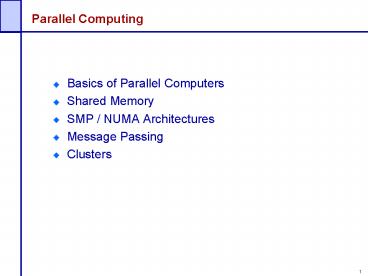Parallel Computing - PowerPoint PPT Presentation
Title:
Parallel Computing
Description:
... is how much communication per unit of computation. ... Type of processor communications used ... Remote Cache to reduce access latency (think of it as an L3) ... – PowerPoint PPT presentation
Number of Views:36
Avg rating:3.0/5.0
Title: Parallel Computing
1
Parallel Computing
- Basics of Parallel Computers
- Shared Memory
- SMP / NUMA Architectures
- Message Passing
- Clusters
2
Why Parallel Computing
- No matter how effective ILP/Moores Law, more is
better - Most systems run multiple applications
simultaneously - Overlapping downloads with other work
- Web browser (overlaps image retrieval with
display) - Total cost of ownership favors fewer systems with
multiple processors rather than more systems
w/fewer processors
Peak performance increases linearly with more
processors Adding processor/memory much cheaper
than a second complete system
2PM
2P2M
Price
PM
Performance
3
What about Sequential Code?
- Sequential programs get no benefit from multiple
processors, they must be parallelized. - Key property is how much communication per unit
of computation. The less communication per unit
computation the better the scaling properties of
the algorithm. - Sometimes, a multi-threaded design is good on uni
multi-processors e.g., throughput for a web
server (that uses system multi-threading) - Speedup is limited by Amdahls Law
- Speedup lt 1/(seq (1 seq)/proc)
- as proc -gt infinity, Speedup is
limited to 1/seq - Many applications can be (re)designed/coded/compil
ed to generate cooperating, parallel instruction
streams specifically to enable improved
responsiveness/throughput with multiple
processors.
4
Performance of parallel algorithms is NOT limited
by which factor
- The need to synchronize work done on different
processors. - The portion of code that remains sequential.
- The need to redesign algorithms to be more
parallel. - The increased cache area due to multiple
processors.
5
Parallel Programming Models
- Parallel programming involves
- Decomposing an algorithm into parts
- Distributing the parts as tasks which are worked
on by multiple processors simultaneously - Coordinating work and communications of those
processors - Synchronization
- Parallel programming considerations
- Type of parallel architecture being used
- Type of processor communications used
- No automated compiler/language exists to automate
this parallelization process. - Two Programming Models exist..
- Shared Memory
- Message Passing
6
Process CoordinationShared Memory v. Message
Passing
- Shared memory
- Efficient, familiar
- Not always available
- Potentially insecure
global int x
process foo begin x ... end foo
process bar begin y x end bar
- Message passing
- Extensible to communication in distributed systems
Canonical syntax
send(process process_id, message
string) receive(process process_id, var message
string)
7
Shared Memory Programming Model
- Programs/threads communicate/cooperate via
loads/stores to memory locations they share. - Communication is therefore at memory access speed
(very fast), and is implicit. - Cooperating pieces must all execute on the same
system (computer). - OS services and/or libraries used for creating
tasks (processes/threads) and coordination
(semaphores/barriers/locks.)
8
Shared Memory Code
- fork N processes
- each process has a number, p, and computes
- istartp, iendp, jstartp, jendp
- for(s0sltSTEPSs)
- k s1 m k1
- forall(iistartpiltiendpi)
- forall(jjstartpjltjendpj)
- akij c1amij
c2ami-1j - c3ami1j c4amij-1
- c5amij1 // implicit comm
- barrier()
9
Symmetric Multiprocessors
- Several processors share one address space
- conceptually a shared memory
- Communication is implicit
- read and write accesses to shared memory
locations - Synchronization
- via shared memory locations
- spin waiting for non-zero
- Atomic instructions (Testset, compareswap, load
linked/store conditional) - barriers
P
P
P
Network
M
Conceptual Model
10
Non-Uniform Memory Access - NUMA
- CPU/Memory busses cannot support more than 4-8
CPUs before bus bandwidth is exceeded (the SMP
sweet spot). - To provide shared-memory MPs beyond these limits
requires some memory to be closer to some
processors than to others.
- The Interconnect usually includes
- a cache-directory to reduce snoop traffic
- Remote Cache to reduce access latency (think of
it as an L3) - Cache-Coherent NUMA Systems (CC-NUMA)
- SGI Origin, Stanford Dash, Sequent NUMA-Q, HP
Superdome - Non Cache-Coherent NUMA (NCC-NUMA)
- Cray T32E
11
Message Passing Programming Model
- Shared data is communicated using
send/receive services (across an external
network). - Unlike Shared Model, shared data must be
formatted into message chunks for distribution
(shared model works no matter how the data is
intermixed). - Coordination is via sending/receiving messages.
- Program components can be run on the same or
different systems, so can use 1,000s of
processors. - Standard libraries exist to encapsulate
messages - Parasoft's Express (commercial)
- PVM (standing for Parallel Virtual Machine,
non-commercial) - MPI (Message Passing Interface, also
non-commercial).
12
Message Passing IssuesSynchronization semantics
- When does a send /receive operation terminate?
Blocking (aka Synchronous) Sender waits until
its message is received Receiver waits if no
message is available
Non-blocking (aka Asynchronous) Send operation
immediately returns Receive operation returns
if no message is available (polling)
Partially blocking/non-blocking send()/receive()
with timeout
13
Clustered Computers designed for Message Passing
- A collection of computers (nodes) connected by a
network - computers augmented with fast network interface
- send, receive, barrier
- user-level, memory mapped
- otherwise indistinguishable from conventional PC
or workstation - One approach is to network workstations with a
very fast network - Often called cluster computers
- Berkeley NOW
- IBM SP2 (remember Deep Blue?)
14
Which is easier to program?
- Shared memory
- Message passing

